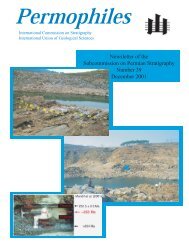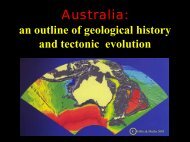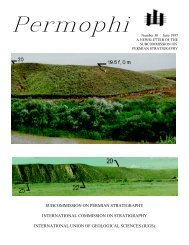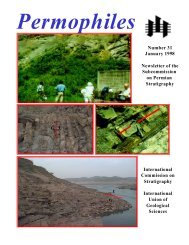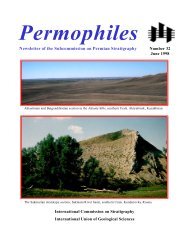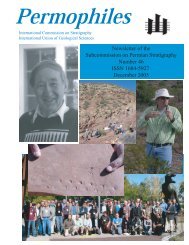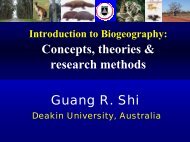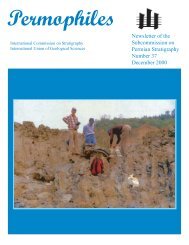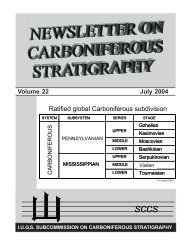Newsletter of the Subcommission on Permian Stratigraphy Number ...
Newsletter of the Subcommission on Permian Stratigraphy Number ...
Newsletter of the Subcommission on Permian Stratigraphy Number ...
Create successful ePaper yourself
Turn your PDF publications into a flip-book with our unique Google optimized e-Paper software.
Plummer, F. B. and Scott, G., 1937, The geology <str<strong>on</strong>g>of</str<strong>on</strong>g> Texas, VolumeIII, Part 1: Upper Paleozoic amm<strong>on</strong>ites in Texas: The University<str<strong>on</strong>g>of</str<strong>on</strong>g> Texas Bulletin 3701, p. 13-516.Reisz, R. R. and Laurin, M. 2001, The reptile Macroleter, <str<strong>on</strong>g>the</str<strong>on</strong>g> firstvertebrate evidence for correlati<strong>on</strong> <str<strong>on</strong>g>of</str<strong>on</strong>g> Upper <strong>Permian</strong> c<strong>on</strong>tinentalstrata <str<strong>on</strong>g>of</str<strong>on</strong>g> North America and Russia: Geological Society<str<strong>on</strong>g>of</str<strong>on</strong>g> America Bulletin, in press.Ross, C. A. 1987, Le<strong>on</strong>ardian Series (<strong>Permian</strong>), Glass Mountains,West Texas, in Cromwell, D. and Mazzullo, L., eds., TheLe<strong>on</strong>ardian Facies in W. Texas and S. E. New Mexico andGuidebook to <str<strong>on</strong>g>the</str<strong>on</strong>g> Glass Mountains, West Texas: SEPM<strong>Permian</strong> Basin Secti<strong>on</strong>, Midland, p. 25-33.Ross, C. A. and Ross, J. P. R., 1988, Late Paleozoic transgressiveregressivedepositi<strong>on</strong>: SEPM Special Publicati<strong>on</strong> 42, p. 227-247.Rubidge, B. S., 1995, Biostratigraphy <str<strong>on</strong>g>of</str<strong>on</strong>g> <str<strong>on</strong>g>the</str<strong>on</strong>g> Eodicynod<strong>on</strong>Assemblage Z<strong>on</strong>e: South African Committee for <strong>Stratigraphy</strong>,Biostratigraphic Series, 1, p. 3-7.Rubidge, B. S. and Hops<strong>on</strong>, J. A., 1990, A new anomod<strong>on</strong>t<str<strong>on</strong>g>the</str<strong>on</strong>g>rapsid from South Africa and its bearing <strong>on</strong> <str<strong>on</strong>g>the</str<strong>on</strong>g> ancestry <str<strong>on</strong>g>of</str<strong>on</strong>g>Dicynod<strong>on</strong>tia: South African Journal <str<strong>on</strong>g>of</str<strong>on</strong>g> Science, v. 86, p. 43-45.Rubidge, B. S. and Hops<strong>on</strong>, J. A., 1996, A primitive anomod<strong>on</strong>t<str<strong>on</strong>g>the</str<strong>on</strong>g>rapsid from <str<strong>on</strong>g>the</str<strong>on</strong>g> base <str<strong>on</strong>g>of</str<strong>on</strong>g> <str<strong>on</strong>g>the</str<strong>on</strong>g> Beaufort Group (Upper<strong>Permian</strong>) <str<strong>on</strong>g>of</str<strong>on</strong>g> South Africa: Zoological Journal <str<strong>on</strong>g>of</str<strong>on</strong>g> <str<strong>on</strong>g>the</str<strong>on</strong>g> LinneanSociety, v. 117, p. 115-139.Sidor, C. A. and Hops<strong>on</strong>, J. A, 1995, The tax<strong>on</strong>omic status <str<strong>on</strong>g>of</str<strong>on</strong>g> <str<strong>on</strong>g>the</str<strong>on</strong>g>Upper <strong>Permian</strong> eo<str<strong>on</strong>g>the</str<strong>on</strong>g>riod<strong>on</strong>t <str<strong>on</strong>g>the</str<strong>on</strong>g>rapsids <str<strong>on</strong>g>of</str<strong>on</strong>g> <str<strong>on</strong>g>the</str<strong>on</strong>g> San AngeloFormati<strong>on</strong> (Guadalupian), Texas: Journal <str<strong>on</strong>g>of</str<strong>on</strong>g> VertebratePale<strong>on</strong>tology, v. 15 (supplement to 3), p. 53A.Tharals<strong>on</strong>, D. B., 1984, Revisi<strong>on</strong> <str<strong>on</strong>g>of</str<strong>on</strong>g> <str<strong>on</strong>g>the</str<strong>on</strong>g> <strong>Permian</strong> amm<strong>on</strong>oid familyPerrinitidae: Journal <str<strong>on</strong>g>of</str<strong>on</strong>g> Pale<strong>on</strong>tology, v. 58, p. 804-833.Yefremov, I. A., 1937, On <str<strong>on</strong>g>the</str<strong>on</strong>g> stratigraphic subdivisi<strong>on</strong> <str<strong>on</strong>g>of</str<strong>on</strong>g> <str<strong>on</strong>g>the</str<strong>on</strong>g>c<strong>on</strong>tinental <strong>Permian</strong> and Triassic <str<strong>on</strong>g>of</str<strong>on</strong>g> <str<strong>on</strong>g>the</str<strong>on</strong>g> USSR <strong>on</strong> <str<strong>on</strong>g>the</str<strong>on</strong>g> basis <str<strong>on</strong>g>of</str<strong>on</strong>g><str<strong>on</strong>g>the</str<strong>on</strong>g> fauna <str<strong>on</strong>g>of</str<strong>on</strong>g> early Tetrapoda: Doklady Akademiya Nauk SSSR,v. 16, p. 121-126.Yefremov, I. A., 1956, American elements in <str<strong>on</strong>g>the</str<strong>on</strong>g> fauna <str<strong>on</strong>g>of</str<strong>on</strong>g> <str<strong>on</strong>g>the</str<strong>on</strong>g>USSR: Doklady Akademiya Nauk SSSR, v. 111, p. 1091-1094.Re-discussi<strong>on</strong> <str<strong>on</strong>g>of</str<strong>on</strong>g> <str<strong>on</strong>g>the</str<strong>on</strong>g> Base <str<strong>on</strong>g>of</str<strong>on</strong>g> <str<strong>on</strong>g>the</str<strong>on</strong>g> Lopingian SeriesWang Cheng-yuanNanjing Institute <str<strong>on</strong>g>of</str<strong>on</strong>g> Geology and Palae<strong>on</strong>tology, Academia Sinica,Nanjing, 210008, China. E-mail address; cywang@nigpas.ac.cnThis paper presents a discussi<strong>on</strong> <strong>on</strong> proposals for definiti<strong>on</strong> <str<strong>on</strong>g>of</str<strong>on</strong>g><str<strong>on</strong>g>the</str<strong>on</strong>g> base Lopingian GSSP which also has implicati<strong>on</strong>s relating to<str<strong>on</strong>g>the</str<strong>on</strong>g> main principles for <str<strong>on</strong>g>the</str<strong>on</strong>g> establishment <str<strong>on</strong>g>of</str<strong>on</strong>g> GSSPs in general. Thefollowing two points are noteworthy.1. A gap and/or diastem (small gap at a bending plane) is presentbetween beds 6i lower and upper.I may c<strong>on</strong>clude from <str<strong>on</strong>g>the</str<strong>on</strong>g> following descripti<strong>on</strong>s made byprevious authors that <str<strong>on</strong>g>the</str<strong>on</strong>g>re is a small gap or diastem (small gap at<str<strong>on</strong>g>the</str<strong>on</strong>g> bedding plane) between beds 6i lower and upper, even if thisis not regarded as an unc<strong>on</strong>formity.Henders<strong>on</strong> (Jin, 2000b) wrote “It could be argued that <str<strong>on</strong>g>the</str<strong>on</strong>g>Permophiles Issue #38 200127abrupt change from J. granti to C. postbitteri is indicative <str<strong>on</strong>g>of</str<strong>on</strong>g> anunc<strong>on</strong>formity and that <str<strong>on</strong>g>the</str<strong>on</strong>g> breccia could support this.”Mei et al. (1998) also described :“… debris flow depositsoccur less frequently in <str<strong>on</strong>g>the</str<strong>on</strong>g> Penglaitan secti<strong>on</strong>. The MaokouFormati<strong>on</strong> comprises mainly thin-bedded cherty wackest<strong>on</strong>e,diagenetic chert, carb<strong>on</strong>ate turbidite and debris flow deposits”.Mei et al. (1998) also show in Text-figure 3 that cross beddingand crinoid debris are present in <str<strong>on</strong>g>the</str<strong>on</strong>g> uppermost MaokouFormati<strong>on</strong>. It is thus noteworthy that <str<strong>on</strong>g>the</str<strong>on</strong>g>re is breccia, debris,and cross bedding in <str<strong>on</strong>g>the</str<strong>on</strong>g> uppermost part <str<strong>on</strong>g>of</str<strong>on</strong>g> <str<strong>on</strong>g>the</str<strong>on</strong>g> MaokouFormati<strong>on</strong>.Henders<strong>on</strong> stated (Jin, 2000b) “I agree with you (=Jin) that <str<strong>on</strong>g>the</str<strong>on</strong>g>term diastem is very appropriate for this bedding plane c<strong>on</strong>tactbetween 6i lower and upper. Shil<strong>on</strong>g Mei would probably regardthis as <str<strong>on</strong>g>the</str<strong>on</strong>g> correlative c<strong>on</strong>formable surface associated with <str<strong>on</strong>g>the</str<strong>on</strong>g> G/L sequence boundary <strong>on</strong> <str<strong>on</strong>g>the</str<strong>on</strong>g> shelf/platform. I d<strong>on</strong>’t believe that<str<strong>on</strong>g>the</str<strong>on</strong>g>re is any <strong>on</strong>e correlative c<strong>on</strong>formable surface, but ra<str<strong>on</strong>g>the</str<strong>on</strong>g>r aninterval. However, it seems clear that <str<strong>on</strong>g>the</str<strong>on</strong>g>re is a turn-around in sealevel at this point and applying <str<strong>on</strong>g>the</str<strong>on</strong>g> Transgressive- Regressivesequence model <str<strong>on</strong>g>of</str<strong>on</strong>g> Embry, this point could be viewed as <str<strong>on</strong>g>the</str<strong>on</strong>g> beginning<str<strong>on</strong>g>of</str<strong>on</strong>g> a new sequence in a c<strong>on</strong>formable successi<strong>on</strong>.”It is thus clear that:a. Both Jin and Henders<strong>on</strong> are c<strong>on</strong>vinced that <str<strong>on</strong>g>the</str<strong>on</strong>g>re is a diastembetween lower and upper 6i. What is a diastem? A diastem isa gap at a bedding plane or in o<str<strong>on</strong>g>the</str<strong>on</strong>g>r words, a bedding planecaused by a small gap. Only some marine bedding planes arec<strong>on</strong>nected with a gap, mostly <str<strong>on</strong>g>the</str<strong>on</strong>g> bedding planes simply indicatechanges in physical c<strong>on</strong>diti<strong>on</strong> as supply <str<strong>on</strong>g>of</str<strong>on</strong>g> finer or coarsermaterial. Not every bedding plane is a diastem.b. This boundary is a sequence boundary, and could be viewedas <str<strong>on</strong>g>the</str<strong>on</strong>g> beginning <str<strong>on</strong>g>of</str<strong>on</strong>g> a new sequence (Text-fig.1).c. Henders<strong>on</strong> does not believe that <str<strong>on</strong>g>the</str<strong>on</strong>g>re is any <strong>on</strong>e correlativec<strong>on</strong>formable surface, but ra<str<strong>on</strong>g>the</str<strong>on</strong>g>r an interval.Mei, Jin and Henders<strong>on</strong> have supported <str<strong>on</strong>g>the</str<strong>on</strong>g> boundary betweenlower and upper 6i as a GSSP for <str<strong>on</strong>g>the</str<strong>on</strong>g> base <str<strong>on</strong>g>of</str<strong>on</strong>g> <str<strong>on</strong>g>the</str<strong>on</strong>g> Lopingian.The definiti<strong>on</strong> <str<strong>on</strong>g>of</str<strong>on</strong>g> such a GSSP boundary at a small gap or diastemis at variance with <str<strong>on</strong>g>the</str<strong>on</strong>g> Internati<strong>on</strong>al Stratigraphic Guide “Theboundary-stratotype <str<strong>on</strong>g>of</str<strong>on</strong>g> a stage should be within a sequence <str<strong>on</strong>g>of</str<strong>on</strong>g>c<strong>on</strong>tinuous depositi<strong>on</strong>” (Hedberg,1976) and also with <str<strong>on</strong>g>the</str<strong>on</strong>g> Internati<strong>on</strong>alCommissi<strong>on</strong> <strong>on</strong> <strong>Stratigraphy</strong>’s guidelines for <str<strong>on</strong>g>the</str<strong>on</strong>g> establishment<str<strong>on</strong>g>of</str<strong>on</strong>g> GSSPs (Remane et al., 1996).2. What is necessary for <str<strong>on</strong>g>the</str<strong>on</strong>g> establishment <str<strong>on</strong>g>of</str<strong>on</strong>g> a GSSP: supposedpunctuated evoluti<strong>on</strong> or c<strong>on</strong>crete evoluti<strong>on</strong>ary lineage?Henders<strong>on</strong> (2000) pointed out “<str<strong>on</strong>g>the</str<strong>on</strong>g>re are many philosophicaland tax<strong>on</strong>omic issues that need to be c<strong>on</strong>sidered before a finalc<strong>on</strong>sensus <strong>on</strong> <str<strong>on</strong>g>the</str<strong>on</strong>g> Guadalupian-Lopingian boundary can bereached. One <str<strong>on</strong>g>of</str<strong>on</strong>g> <str<strong>on</strong>g>the</str<strong>on</strong>g>se issues involves how <str<strong>on</strong>g>the</str<strong>on</strong>g> nature <str<strong>on</strong>g>of</str<strong>on</strong>g> evoluti<strong>on</strong>arymode and tempo affect our tax<strong>on</strong>omic c<strong>on</strong>cepts. If <strong>on</strong>eargues that c<strong>on</strong>od<strong>on</strong>t species <strong>on</strong>ly arise by phyletic gradualism,<str<strong>on</strong>g>the</str<strong>on</strong>g>n it is clear it would be difficult to imagine Jinog<strong>on</strong>dolellagranti as <str<strong>on</strong>g>the</str<strong>on</strong>g> ancestor to C. postbitteri as Wang and Kozur suggest.However, if punctuated evoluti<strong>on</strong>ary events are c<strong>on</strong>sidered,<str<strong>on</strong>g>the</str<strong>on</strong>g>n <str<strong>on</strong>g>the</str<strong>on</strong>g> ancestor relati<strong>on</strong>ship <str<strong>on</strong>g>of</str<strong>on</strong>g> <str<strong>on</strong>g>the</str<strong>on</strong>g>se two taxa become moreprobable since very different morphologies would be expected.The clarity <str<strong>on</strong>g>of</str<strong>on</strong>g> such a rapid event would make an ideal boundarypositi<strong>on</strong> for a GSSP. This point occurs at <str<strong>on</strong>g>the</str<strong>on</strong>g> boundary betweenlower bed 6i and upper bed 6i.”With regard to <str<strong>on</strong>g>the</str<strong>on</strong>g>se points <str<strong>on</strong>g>of</str<strong>on</strong>g> view I wish to point out <str<strong>on</strong>g>the</str<strong>on</strong>g>



